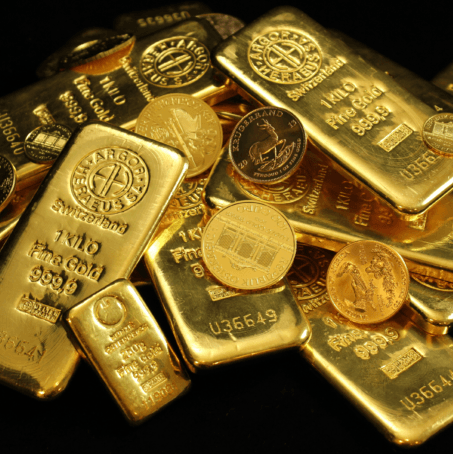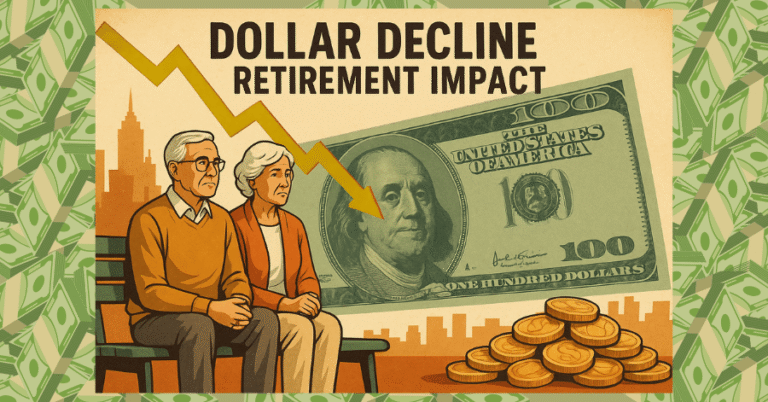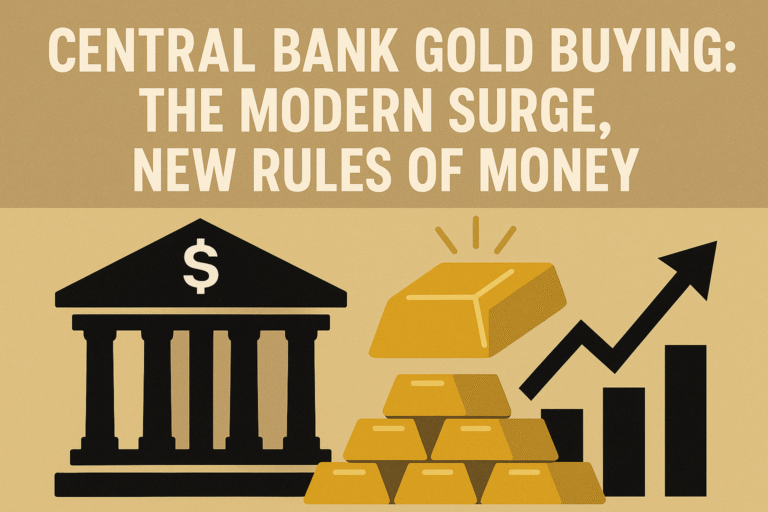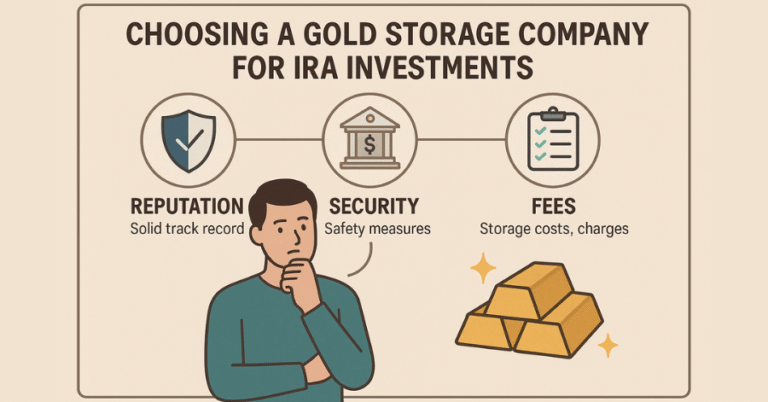Key Takeaways:
A Signal for Retirement Savers: The reasons central banks buy gold (safety, diversification, inflation protection) are the same reasons many investors consider adding gold to their own retirement strategies.
Historic Central Bank Gold Buying: Central banks are on an unprecedented gold buying spree, acquiring over 1,000 tonnes for the third consecutive year, signaling a major shift in global finance.
Diversifying Away from the U.S. Dollar: A primary motivation is to reduce reliance on the U.S. dollar, with BRICS+ nations leading the push to hedge against geopolitical risk and inflation.
Gold as the Ultimate Safe-Haven Asset: In 2025, global institutions are turning to gold as a stable store of value that is independent of any single nation’s currency or political instability.
Creating Strong Gold Price Support: This massive and sustained institutional demand creates a strong price support floor for gold, showing powerful confidence in its long-term value.
Affiliate Disclosure: To support our mission of providing valuable financial analysis, this page may contain affiliate links. If you follow a link and make a purchase, we may earn a commission at no additional cost to you. We only recommend partners we thoroughly research and trust.
Read Our Article: Rio Reset Dollar Shakedown
 Is Gold Your Retirement Shield?
Is Gold Your Retirement Shield?
Introduction: Why Central Banks Buy Gold
Why Central Banks Buy Gold 2025, a significant trend is capturing the attention of financial observers worldwide. Central banks are accumulating gold at a pace not seen in decades. This isn’t a random occurrence; it’s a calculated strategy by some of the world’s largest financial institutions.
Understanding why central banks buy gold in 2025 offers a crucial window into their assessment of the global economic climate. Their concerns about traditional fiat currencies and the potential long-term shifts heralded by events like the “Rio Reset.” For individual savers and investors, these institutional moves can be a telling indicator of underlying economic currents.
Motivations Behind the Bullion Buying
Several key factors explain why central banks buy gold in 2025 with such vigor.
Firstly
Gold serves as a hedge against geopolitical risks and economic uncertainty. In an era of shifting global alliances and potential currency realignments. Gold offers a store of value independent of any single nation’s economic policy.
Secondly
Persistent inflationary pressures and concerns about the long-term stability of major fiat currencies make gold an attractive diversification asset.
Central banks, particularly those in emerging markets and the BRICS+ bloc. Such as China and India are keen to reduce their reliance on U.S. dollar reserves. With the intent to bolster their financial sovereignty.
Impact on the Gold Market and Individuals
This sustained demand from central banks creates a strong support floor for gold market prices. Which signals a broader confidence in the metal’s enduring value. When institutional players make such significant moves, it often prompts individual investors to re-evaluate their strategies.
The reasons why central banks buy gold in 2025—seeking stability, hedging against inflation, and diversifying away from currency risks. These are often the same reasons individuals consider adding gold to their retirement portfolios, perhaps through a Gold IRA.
Frequently Asked Questions: Central Bank Gold Buying and Your Finances
This FAQ section is intended to address the key questions that arise from the trend of central banks accumulating gold.
Q1: Why are central banks buying so much gold now?
Central banks are buying gold for several strategic reasons that reflect their assessment of the current global economic climate:
- Diversification from the U.S. Dollar: Many countries, particularly emerging markets, are actively reducing their reliance on the U.S. dollar to limit their exposure to U.S. monetary policy and geopolitical risks.
- Hedge Against Inflation: Gold has historically served as a reliable hedge against inflation. As governments worldwide have increased their money supply, central banks are using gold to protect the purchasing power of their reserves.
- Safe-Haven Asset: In times of geopolitical instability and market uncertainty, gold is considered the ultimate safe-haven asset because its value is not tied to any single government’s promises or financial system. It acts as a form of financial insurance.
- Performance During Crisis: Gold has a proven track record of performing well during economic crises when other assets, like stocks and bonds, may fall in value.
Q2: Does this massive buying from central banks guarantee that the price of gold will go up?
No, it does not guarantee a price increase, but it creates very strong support for the price. Think of it in terms of supply and demand. When a group of large, consistent, and price-insensitive buyers (central banks) removes thousands of tonnes of gold from the market, it significantly reduces the available supply for everyone else. This massive demand helps to create a “price floor,” making a major price collapse less likely and providing a strong foundation for future price growth. However, gold prices are still subject to other market forces, including interest rates, investment demand, and short-term speculation.
Q3: The article focuses on other countries buying gold. What about the United States?
This is a key point of context. The United States holds the largest official gold reserve in the world by a significant margin, with over 8,133 metric tons. Because the U.S. already has such vast holdings, it is not an active buyer or seller on the market. Its reserves are treated as a legacy strategic asset, a foundation of its financial strength. The current trend is about other nations trying to increase their own reserves to a more strategically significant level, often to counterbalance the financial influence of the U.S. dollar.
Q4: The article mentions this is the 15th consecutive year of net buying. What were central banks doing before that?
Before this trend began around the 2008 Global Financial Crisis, central banks were actually net sellers of gold for about two decades. During the relatively stable economic period of the 1990s and early 2000s, gold was seen by some Western central banks as a “dead asset” because it doesn’t earn interest or dividends. They sold off portions of their reserves to invest in interest-bearing assets like U.S. Treasury bonds. The 2008 crisis marked a major turning point, reminding global institutions of the risks in the fiat currency system and reigniting gold’s appeal as the ultimate safe-haven asset.
Q5: How does this gold-buying trend connect to the “Rio Reset” mentioned in the article?
The “Rio Reset” is a concept that refers to the accelerated efforts by the BRICS+ nations (Brazil, Russia, India, China, South Africa, and their allies) to create a parallel financial system that is less dependent on the U.S. dollar. A key part of this strategy is anchoring their reserves and potentially new trade systems with a universally recognized, neutral asset. Gold fits this role perfectly. By accumulating massive gold reserves, these nations aim to add credibility and stability to their de-dollarization efforts, making gold a foundational piece of the “Rio Reset” puzzle.
Q6: If these reasons for owning gold apply to me, what are my options for investing?
An individual investor has several ways to gain exposure to gold, each with different benefits:
- Gold IRA: Allows you to hold physical, IRS-approved gold bars and coins within a tax-advantaged retirement account. This is ideal for long-term wealth preservation and hedging your retirement savings.
- Physical Bullion (Outside an IRA): You can buy gold bars and coins directly from dealers. This gives you direct, tangible ownership but requires you to arrange for secure storage and insurance.
- Gold ETFs (Exchange-Traded Funds): These are funds that trade like stocks and hold large amounts of gold. They offer high liquidity and low transaction costs but you do not own the physical metal yourself; you own shares in a trust that owns the gold.
- Gold Mining Stocks: Investing in the companies that mine gold. The value of these stocks is influenced by gold prices but also by company management, operational efficiency, and broader stock market trends.
Q7: What are the potential risks or downsides of investing in gold I should consider?
While gold is a powerful tool for diversification and safety, it’s important to be aware of its characteristics:
- No Yield: Unlike stocks that can pay dividends or bonds that pay interest, gold does not generate any income. Its return comes solely from its price appreciation.
- Price Volatility: While seen as a long-term store of value, the price of gold can be volatile in the short term.
- Costs: Owning physical gold comes with costs, including dealer markups when you buy and sell, as well as potential storage and insurance fees. Gold IRAs have annual custodian and storage fees.
Conclusion
The intensified gold acquisition by central banks in 2025 is more than just a market trend; it’s a reflection of a changing global economic landscape and a strategic repositioning in anticipation of future uncertainties, including those related to the “Rio Reset.” For individuals, observing these large-scale financial maneuvers can provide valuable insights into prudent wealth preservation strategies.
To understand how these trends fit into the larger picture of global financial shifts, explore our main guide: “Rio Reset Dollar Shakedown: Is Gold Your Retirement’s Unseen Shield?”







One Comment